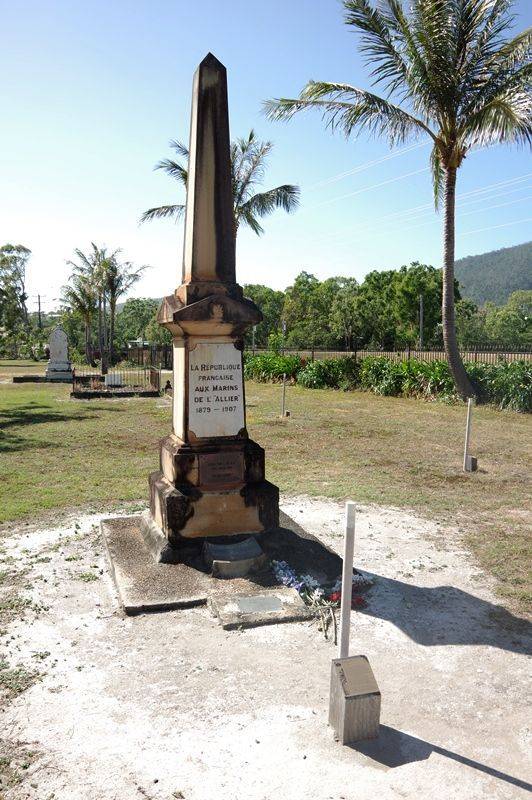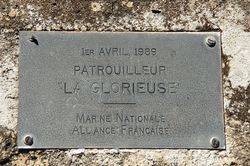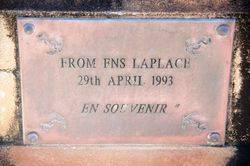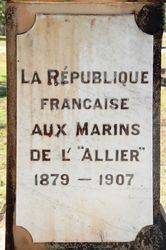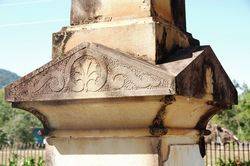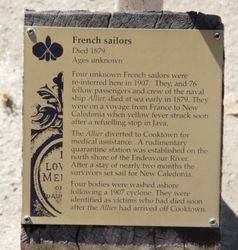
French SailorsPrint Page 
The monument erected by the French Government over the grave commemorates French sailors from the French naval vessel Allier who died of yellow fever or smallpox on a voyage from France to New Caledonia in 1879.
On Sunday 9 February 1879, a French naval vessel arrived in Cooktown, this was the new steam-powered French dispatch-transport the Allier (1650 tons). She had left France the previous November bound for New Caledonia with a crew of 102 men and 228 soldiers. En route she visited Java and, there, a fever, either malarial or typhoid (later even described as smallpox) was contracted and quickly began to infect those on board. By the time the Allier diverted to Cooktown for medical supplies, twenty-one deaths had occurred and 157 others were ailing. Almost certainly ship-handling had also become seriously impaired as a result of so many sick cases.
Facing Cooktown was a pre-existing quarantine area on the north shore of the Endeavour River and the Allier’s captain, Félix-Guillaume Coulombeaud (1832–1909) (later rear-admiral Coulombeaud), established a temporary hospital camp there and also sought fresh provisions. During his stay of some weeks, there were at least thirteen deaths. These mainly young men in their twenties were buried on the north shore, about a hundred metres from the beach, and a monument to their memory was erected and enclosed by a fence. The location of their graves was not discovered until 1905 when they were removed and re-interred in Cooktown Cemetery.
Note : The details on the information plaque at the gravesite differs from the newspaper articles written at the time.
The remains of the Frenchmen from the transport L'Allier, which in 1879 put into Cooktown with smallpox aboard, and landed and were buried in unconsecrated ground, were reinterred to-day. Several searches had been made at different times for the bodies, which were recently accidentally discovered. At 11 a.m. the Rev. Father Dempsey received the remains—those of eight French marines and one sailor rated as third-class—and Sergeant King placed them in the hearse which conveyed them to St. Mary's Church. The remains were enclosed in an ornamented coffin with a heavy bronze lid, on which were the names of the nine dead Frenchmen. A candelabra of three lights was placed on each side of the coffin. Later in the day the remains were laid in state. At a quarter to 4 in the afternoon over 500 people mustered in the church, including 250 children from the State and Catholic schools. A solemn requiem mass was celebrated. The Rev. Father Dempsey, in full canonicals, conducted the ceremonies. The organist played the Dead March, and the choir moved outside in procession. The Hibernians formed a guard of honour as the coffin was borne to the hearse from the church, and the police marshalled the procession in full uniform, headed by Sergeant King. Upon arrival at the cemetery the State school boys stood at attention, and saluted as the coffin was borne between their ranks. The band continued to play solemn music, and at the at the graveside rendered the " Marseillaise." Flags were hoisted at half-mast in the town. On the public flagstaff the British and French flags were entwined, and at other places the tri-colour was hoisted. Mr. Douglas Hall, the discoverer of the French remains, took a central part in the procession.
The Queenslander (Brisbane), 13 May 1905.
The last chapter may now be written of a melancholy story which had its beginning in the then remote regions of North Queensland nearly forty years ago. During the stay at Cooktown of a French ship of war named the Allier, eight of her sailors were stricken to death by fever. They were buried by the ship's company in a lonely spot on the North Shore, some distance from the settlement, and though some pains seems to have been taken to mark the last resting place of the men, the lonely grave appears to have soon been forgotten. Some years after Commodore Boyle, of the French Pacific Station, drew the attention of the French authorities to the neglected condition of the grave, but nothing was done at that time. A stone tablet, which bore the names of the men, was eventually found, and removed to the Roman Catholic Presbytery at Cooktown, but by the time further action was decided upon the exact location of the grave could not be discovered. Eventually a lad named Douglas Hall found all that had been left consisting of some skulls and bone, pieces of cloth and naval buttons, etc., and received a reward. The spot was carefully examined by the authorities, every fragment was gathered up, and on May 3, 1905, a public funeral was given them at the Cooktown Cemetery. The last chapter consists of the erection over the grave of a suitable memorial, which has just been completed by Mr. A. L. Petrie, and forwarded by steamer.
The Brisbane Courier (Qld), 16 July 1907.
Location
| Address: | Charlotte & John Streets, Cooktown Cemetery, Cooktown, 4895 |
|---|---|
| State: | QLD |
| Area: | Foreign |
| GPS Coordinates: | Lat: -15.477346 Long: 145.241761 Note: GPS Coordinates are approximate. |
Details
| Monument Type: | Grave |
|---|---|
| Monument Theme: | Disaster |
| Sub-Theme: | Pandemic |
| Designer: | Mr A. L. Petrie |
Dedication
| Approx. Monument Dedication Date: | July-1907 |
|---|
La République Francaise
Aux Marins de L` "Allier"
1879 - 1907
Plaque :
From FNS Laplace
29th April 1993
"En Souvenir"


